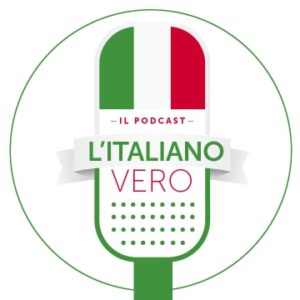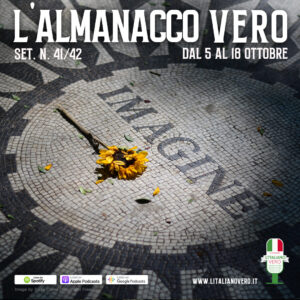L’Almanacco Vero sett. n. 41-42 dal 5 al 18 ottobre ’20
Blog in italiano – tempo di lettura: 6 min
Blog in English – reading time: 6 min
________________
Blog in italiano
Cari ascoltatori, eccoci insieme per un nuovo appuntamento con l’almanacco bisettimanale!
A costo di sembrarvi ripetitivi, vogliamo ringraziarvi per l’affetto con cui ci seguite sempre più numerosi! Anche questa settimana diamo infatti il benvenuto ai nuovi ascoltatori e ai nuovi sostenitori: Chris, Francisco, Sandy, Andreia e Matthew.
Cubo potrebbe cominciare a montarsi la testa (esaltarsi, darsi delle arie) ma ci siamo io e Michela a ricordargli di volare basso (essere modesto non essere troppo ambizioso)!😉
Ecco allora gli argomenti di questo episodio che nascondono inaspettatamente piccoli aneddoti italiani:
7 ottobre
1952 – Brevetto del codice a barre (68 anni fa): Furono due ingegneri e inventori statunitensi, al secolo Norman Joseph Woodland e Bernard Silver, a brevettare il codice a barre, (l’insieme di simboli grafici che codifica una serie di informazionI leggibili solo da specifici lettori laser) dopo aver raccolto la segnalazione del titolare di un’impresa alimentare sulla necessità di automatizzare e quindi velocizzare le operazioni di cassa.
I primi esperimenti presero come riferimento il Codice Morse, fu un pacchetto di gomme da masticare il primo prodotto venduto con l’utilizzo di un lettore di codici a barre. Quel prodotto è oggi conservato al Museo Nazionale di Storia Americana di Washington DC.
Oggi abbiamo anche il QR code che però non ha sostituito il vecchio codice a barre.
11 ottobre
1971 – John Lennon pubblica Imagine (49 anni fa): Imagine viene spesso citata come uno dei brani musicali più belli della storia della musica rock; la rivista Rolling Stone, per esempio, l’ha posizionata al terzo posto nella classifica dei migliori brani musicali di tutti i tempi. La forza di questo brano sta certamente anche nel suo grande messaggio pacifista.
Siamo nel pieno della Guerra in Vietnam, con il mondo diviso in due dalla logica della “guerra fredda”. Di fronte a questo scenario la gente, e i giovani soprattutto, manifestano in mille modi il loro desiderio di pace. Il brano risponde pienamente a questa richiesta, invitando a guardare a un futuro possibile, pur se da una condizione di “sognatore”. Ciò ne farà un inno universale di pace per le giovani generazioni di ogni tempo.
Nel 1985, in occasione del quarantacinquesimo anniversario della nascita di Lennon, è stato inaugurato lo Strawberry Fields Memorial: un’area di 10.000 m2 del Central Park di New York dedicata alla memoria del cantante.
Forse in pochi sanno che all’interno di questo memorial, c’è un bellissimo mosaico con la scritta Imagine, realizzato in Campania da artigiani napoletani, che riproduce un antico mosaico pompeiano conservato al Museo Archeologico di Napoli.
Quindi possiamo dire che nel Central Park di New York c’è un pezzettino di Italia!
12 ottobre
1931 – Inaugurato il Cristo Redentore di Rio (89 anni fa): E’ una delle sette meraviglie del mondo, simbolo della città di Rio de Janeiro e del Brasile.
Alta 38 metri, domina lo splendido panorama della baia di Rio. Inizialmente si pensò a una figura diversa, e cioè ad un Cristo che raccogliesse nelle mani un globo, posto su un basamento che rappresentasse il mondo. Alla fine si optò per la versione con le braccia aperte, a simboleggiare una sorta di benvenuto universale, valido sia sul piano religioso che turistico. Visitarla fino a pochi anni fa significava salire 222 gradini, dal 2002 si è provveduto a costruire otto scale mobili e tre elevatori panoramici.
Anche in questa splendida opera c’è un piccolo contributo italiano, infatti l’accensione delle lampade che illuminarono la statua il giorno dell’inaugurazione, avvenne tramite un impulso radio dal’Italia per mano dello scienziato italiano Guglielmo Marconi.
13 ottobre
1884 – Viene Istituito il meridiano di Greenwich (135 anni fa): lunedì 13 ottobre 1884, 41 delegati di 25 nazioni si ritrovarono alla Conferenza internazionale dei Meridiani a Washington, per individuare il meridiano “fondamentale” per sincronizzare gli orologi di tutto il mondo.
Ci fu un duro confronto tra le varie superpotenze che sostenevano ognuna una propria soluzione, legata a ragioni nazionalistiche. In gara c’erano importanti capitali come Berlino, Parigi e la stessa Washington, mentre la delegazione italiana caldeggiava un’alternativa più neutrale, individuata nella città di Gerusalemme.
Alla fine prevalse Greenwich, con un voto contrario (Santo Domingo) e due astenuti (Francia e Brasile). Si scelse per almeno due buoni motivi: il primo è che quel borgo, situato nella parte ovest di Londra, era noto fino a quel momento per un prezioso osservatorio astronomico, in secondo luogo, le mappe geografiche utilizzate nelle principali rotte commerciali (che partivano tutte dalla Gran Bretagna) indicavano Greenwich come meridiano fondamentale.
In passato veniva usata la sigla GMT (Greenwich Mean Time/Tempo medio di Greenwich), per individuare il fuso orario di riferimento della Terra.
Oggi si usa la sigla UTC (Coordinated Universal Time/Tempo Coordinato Universale) per indicare, ad esempio, l’ora degli eventi on line schedulati in differenti parti del mondo.
16 ottobre
1978 – Karol Wojtyla è eletto Papa (42 anni fa): Alle cinque del pomeriggio dal camino della cappella Sistina esce la fumata bianca che simboleggia che i cardinali riuniti in conclave hanno trovato l’accordo sul nome del nuovo Papa. Con la formula Habemus papam (abbiamo il Papa) viene presentato Giovanni Paolo II che fin dalle sue prime parole, pronunciate in un italiano un po’ stentato, dimostra la sua grande capacità comunicativa.
(L’espressione habemus papam la si usa anche in modo figurato quando, dopo una lunga trattativa, si raggiunge un accordo.)
Il mondo è in piena guerra fredda tra l’Occidente e i paesi comunisti, e il nuovo Papa rappresenta l’uomo del dialogo, anche interreligioso. Nella sua lunga vita, intraprende numerosi viaggi apostolici, che lo portano a dialogare con le diplomazie e le culture di tutto il mondo.
Nel 1981 è vittima di un attentato ma si salva, anche se da lì inizieranno i suoi problemi di salute.
Il 2 aprile del 2005 papa Giovanni Paolo II muore e nasce spontanea dalla folla radunata in Piazza San Pietro per i funerali, la richiesta urlata: “Santo subito” cioè si auspica una procedura più rapida per la canonizzazione.
Da allora l’espressione Santo subito si usa anche in modo ironico nei confronti di qualcuno che si autoincensa (che si loda) per le sue azioni impeccabili.
È giunto il momento di salutarci, corro a prendere i figli a scuola!
Ciaoooooo!!!!!
Image by Tresa Carne / Copyright Free
►Ti piace il nostro podcast? sostienici al costo di un caffè
senza di voi non ci sarebbe il podcast:
https://www.patreon.com/litalianoveropodcast
►Trascrizioni episodi:
►Contattaci per idee su nuovi episodi:
https://www.litalianovero.it/wp/contatti/
►Facebook:
https://www.facebook.com/litalianoveropodcast/
►Instagram:
https://www.instagram.com/litalianoveropodcast/
►YouTube
https://bit.ly/2zvrbOK
________________
Blog in Inglese
weeks 41 – 42 from October 5th to 18th
Dear listeners, here we are together for a new installment of the bi-weekly almanac!
At the risk of seeming repetitive, we want to thank you for the affection with which you follow us more and more! Also this week we welcome new listeners and new supporters: Chris, Francisco, Sandy, Andreia and Matthew.
Cubo could start to montarsi la testa “get a big head” (get excited, give himself airs) but it’s Michela and I who remind him to volare basso fly low (be modest, don’t be too ambitious)! 😉
Here then are the topics of this episode that unexpectedly hide small Italian anecdotes:
October 7th
1952 – Patent of the barcode (68 years ago): It was two American engineers and inventors, Norman Joseph Woodland and Bernard Silver, who patented the barcode, (the set of graphic symbols that encode a series of legible information only for specific laser readers) after having received the report from the owner of a food company on the need to automate and therefore speed up cash operations.
The first experiments took Morse Code as a reference, it was a packet of chewing gum the first product sold with the use of a barcode reader. That product is now kept at the Museo Nazionale di Storia Americana (National Museum of American History) in Washington DC.
Today we also have the QR code which however has not replaced the old barcode.
October 11th
1971 – John Lennon releases Imagine (49 years ago): Imagine is often cited as one of the most beautiful pieces of music in the history of rock music; Rolling Stone magazine, for example, placed it third in the ranking of the best music of all time. The strength of this passage certainly also lies in its grande messaggio pacifista (great pacifist message). We are in the midst of the Guerra in Vietnam (Vietnam War), with the world divided in two by the logic of the “cold war”. Faced with this scenario, people, and especially young people, manifest their desiderio di pace (desire for peace) in a thousand ways. This piece fully responds to this request, inviting us to look at a possible future, albeit from a “dreamer” perspective. This will make it a inno universale di pace per le giovani generazioni di ogni tempo (universal hymn of peace for the young generations of all times).
In 1985, on the occasion of the forty-fifth anniversary of Lennon’s birth, the Strawberry Fields Memorial was inaugurated: a 2.5 acre area of Central Park in New York dedicated to the memory of the singer.
Perhaps few know that inside this memorial there is a beautiful mosaic with the inscription Imagine, made in Campania by Neapolitan artisans, which reproduces an ancient mosaico pompeiano (Pompeian mosaic) preserved in the Archaeological Museum of Naples.
So we can say that in New York’s Central Park there is a little piece of Italy!
October 12th
1931 – Christ the Redeemer of Rio inaugurated (89 years ago): It is one of the sette meraviglie del mondo (Seven Wonders of the World), symbol of the city of Rio de Janeiro and Brazil.
38 meters high (98 feet), it dominates the splendid panorama of the Rio bay. Initially, a different figure was thought of, namely a Christ holding a globe in his hands, placed on a base that represented the world. In the end they opted for the version with open arms, to symbolize a sort of universal welcome, valid both on a religious and tourist level. Visiting it until a few years ago meant climbing 222 steps, since 2002 eight escalators and three panoramic elevators have been built.
Also in this splendid work there is a small Italian contribution, in fact l’accensione delle lampade (the lighting of the lamps) that illuminated the statue on the day of the inauguration took place through a radio pulse from Italy by the hand of the Italian scientist Guglielmo Marconi.
October 13th
1884 – The Greenwich meridian is established (135 years ago): on Monday 13 October 1884, 41 delegates from 25 nations gathered at the International Meridian Conference in Washington, to identify the “fundamental” meridian for synchronizing clocks around the world.
There was a harsh confrontation between the various superpowers who each supported their own solution, linked to nationalistic reasons. In the race there were important capitals such as Berlin, Paris and Washington itself, while the Italian delegation advocated a more neutral alternative, identified in the city of Jerusalem.
Eventually Greenwich prevailed, with one vote against (Santo Domingo) and two abstentions (France and Brazil). It was chosen for at least two good reasons: the first is that that village, located in the west of London, was known up to that time for a precious astronomical observatory, and secondly, the geographical maps used in the main commercial routes (which all started from Great Britain) indicated Greenwich as the fundamental meridian.
In the past, the abbreviation GMT (Greenwich Mean Time) was used to identify the Earth’s reference time zone.
Today the acronym UTC (Coordinated Universal Time) is used to indicate, for example, the time of online events scheduled in all over the world.
October 16th
1978 – Karol Wojtyla is elected Pope (42 years ago): At five in the afternoon from the fireplace of the Sistine chapel the fumata Bianca (white smoke) comes out, symbolizing that the cardinals gathered in conclave have found an agreement on the name of the new Pope. With the formula Habemus papam (we have the Pope) Pope John Paul II is presented who from his first words, pronounced in a somewhat broken Italian, demonstrates his great communicative capacity.
(The expression habemus papam is also used figuratively when, after a long negotiation, an agreement is reached.)
The world is in the midst of the cold war between the West and the Communist countries, and the new Pope represents the man of dialogue, including inter religious ones. In his long life, he undertakes numerous apostolic journeys, which lead him to dialogue with diplomacy and cultures from all over the world.
In 1981 he was the victim of an attack but he saved himself, even if his health problems began from there.
On April 2, 2005, Pope John Paul II died and spontaneously arose from the crowd gathered in St. Peter’s Square for the funeral, the shouted request: “Santo subito” (“Holy immediately”), that is, a faster procedure for canonization is hoped for.
Since then, the expression Santo subito has also been used in an ironic way towards someone who autoincensa incenses himself (who praises himself) for his impeccable actions.
The time has come to say goodbye, I run to pick up the children from school!
Ciaoooooo !!!!!
Image by Tresa Carne / Copyright Free
►Did you like the podcast? Please support us at the cost of a coffee
without you there would be no podcast:
https://www.patreon.com/litalianoveropodcast
►Transcripts:
https://www.litalianovero.it/wp/trascrizioni-episodi/
►Contact us for ideas about new podcasts:
https://www.litalianovero.it/wp/contatti/
►Facebook:
https://www.facebook.com/litalianoveropodcast/
►Instagram:
https://www.instagram.com/litalianoveropodcast/
►YouTube
https://bit.ly/2zvrbOK
L'Italiano Vero è un progetto libero finanziato dagli ascoltatori e dalle ascoltatrici.
- 10 – Le dritte per lavorare in Italia – parte 1
 Settembre 9, 2019
Settembre 9, 2019 24 min
24 min - 09 – Dal parrucchiere
 Luglio 29, 2019
Luglio 29, 2019 13 min
13 min - 08 – Il caffè al bar
 Luglio 15, 2019
Luglio 15, 2019 24 min
24 min - 07 – Ma intendi questo… o il prossimo??
 Luglio 1, 2019
Luglio 1, 2019 15 min
15 min - EPISODIO 06 – Caratteri speciali parte 2
 Giugno 17, 2019
Giugno 17, 2019 21 min
21 min - EPISODIO 05 – Caratteri speciali parte 1
 Maggio 30, 2019
Maggio 30, 2019 29 min
29 min - EPISODIO 04 Facciamo le presentazioni parte 2 – Paolo
 Maggio 9, 2019
Maggio 9, 2019 21 min
21 min - EPISODIO 03 – Spelling parte seconda e..”Sanremo”
 Aprile 30, 2019
Aprile 30, 2019 28 min
28 min - EPISODIO 02 – In bocca al Lupo
 Aprile 17, 2019
Aprile 17, 2019 15 min
15 min - EPISODIO 01 – Facciamo le presentazioni parte prima (il Cubo)
 Aprile 10, 2019
Aprile 10, 2019 24 min
24 min - 00 – Parliamo del più e del meno
 Aprile 3, 2019
Aprile 3, 2019 24 min
24 min
- 20 – Il latino vero con Michela – parte 2
 Gennaio 26, 2020
Gennaio 26, 2020 21 min
21 min - 19 – Il latino vero con Michela – parte 1
 Gennaio 12, 2020
Gennaio 12, 2020 20 min
20 min - 18 – Parenti serpenti?
 Dicembre 29, 2019
Dicembre 29, 2019 24 min
24 min - 17 – Italiani veri a Firenze
 Dicembre 15, 2019
Dicembre 15, 2019 21 min
21 min - 16 – Niente di niente
 Dicembre 1, 2019
Dicembre 1, 2019 12 min
12 min - 15 – La dolce vita con Linda
 Novembre 17, 2019
Novembre 17, 2019 min
min - 14 – Un Pinco Pallino qualsiasi
 Novembre 3, 2019
Novembre 3, 2019 20 min
20 min - 13 – L’avvocato del diavolo
 Ottobre 20, 2019
Ottobre 20, 2019 14 min
14 min - 12 – L’uomo del tempo
 Ottobre 7, 2019
Ottobre 7, 2019 9 min
9 min - 11 – Le dritte per lavorare in Italia – parte 2
 Settembre 23, 2019
Settembre 23, 2019 33 min
33 min
- Gli otto Re di Roma con Marco Cappelli – episodio bonus
 Gennaio 9, 2024
Gennaio 9, 2024 6 min
6 min - Flash! 009 Ed è Gol con Antonino Palumbo
 Dicembre 2, 2022
Dicembre 2, 2022 31 min
31 min - Flash! 008 Faccia da funerale
 Ottobre 8, 2022
Ottobre 8, 2022 18 min
18 min - 1 2 3… Grazie Patrons!
 Dicembre 25, 2021
Dicembre 25, 2021 1 min
1 min - Flash! 007 Le vacanze degli Italiani Veri
 Settembre 18, 2021
Settembre 18, 2021 21 min
21 min - Flash! 006 Paolo medaglia di legno
 Agosto 14, 2021
Agosto 14, 2021 17 min
17 min - Flash – C’è da spostare una macchina
 Maggio 4, 2020
Maggio 4, 2020 32 min
32 min - Flash – Italiani veri a Bergamo
 Aprile 12, 2020
Aprile 12, 2020 41 min
41 min - Flash! 003 la mia dolce metà
 Agosto 26, 2019
Agosto 26, 2019 18 min
18 min - Flash! 002 nel traffico
 Agosto 12, 2019
Agosto 12, 2019 11 min
11 min - Flash! Italiani veri a Roma
 Giugno 5, 2019
Giugno 5, 2019 9 min
9 min








Leave a Comment